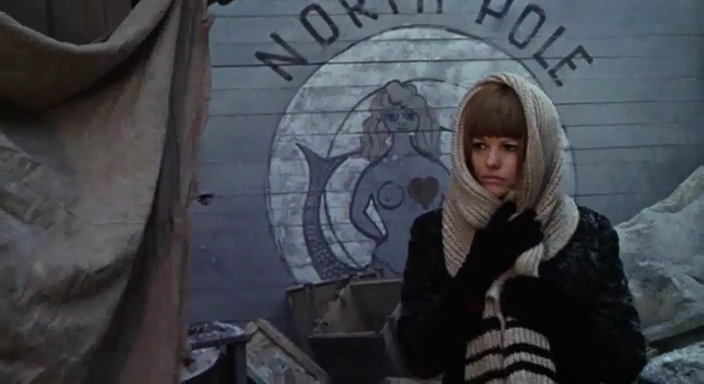The Red Tent

The wreck of the Italia during the Nobile
expedition to the North Pole in 1928 (cf.
Frank Capra’s Dirigible). Forty years and a second world war later, the trial of
General Nobile in his sleepless mind (cf. David MacDonald’s The Bad Lord Byron), an all-important
analytical structure. A mere worldling
(aviator Lundborg) is named prosecutor, no less than Amundsen is granted the last word (a tale of a tub),
Picasso’s Don Quixote is plainly
visible on the wall of the General’s apartment behind Samoilovich
of the icebreaker Krassin.
Kalatozov attends to the facts of the matter as elemental
and sufficient, adverse weather, the human factor, the Arctic.
His screenwriters add to this noblest of tributes the still further
unction of an extremely tenuous understanding that, fine and evanescent as it
is, still reckons up the massive ice floes and terrible sublimity as fair game
for exploration, after all (a graphite resistor tells the tale). For the Valeria theme, cf.
O’Casey’s The
Plough and the Stars (dir. John Ford) or for that matter Shakespeare’s
“Venus and Adonis”, the contrasting Malmgren theme
can perhaps be traced from Lancelot of Lerner & Loewe’s
Camelot (dir. Joshua Logan) and David
Lean’s Lawrence of Arabia (the “purity”
motif).
The
cinematography does all it can to broach the subject of “an awful place” where
the stranded crewmen go “walking on water”. Morricone
takes up the aerial romantic weather of the embarkation in a grand theme that at
the start of the film’s second hour is replaced with stark appreciation
tempered by 2001: A Space Odyssey the
year before, finally he unites the two and finds in a symphonic treatment the
harmonies of Vaughan Williams’ score for Scott
of the Antarctic (dir. Charles Frend), a notable influence on Kubrick.
The title of Kalatozov’s last film, a Russian-Italian co-production like
De Sica’s I girasoli,
refers of course to the canvas shelter that was salvaged from the wreck and
dyed with altitude markers to improve its visibility, something of a “red flag”
as one might say (cf. Fellini’s
rhinoceros and lifeboat in E la nave va) and the probable inspiration (Vertov
has the S.S. Lenin dragging its feet
something awful in Man with a Movie
Camera).
The argument,
which is rapid, difficult and understated in the moments before the disaster
that rips the dirigible’s gondola away from the airframe (subsequently lost
with nearly half the crew remaining on board), is put as Italia’s dilemma in the Royal Italian Air Force under Mussolini,
torn apart by conflicting views that can be found stated with great clarity in
Andrew Marton’s The Thin Red Line,
for example, from Nicholas Ray’s Flying
Leathernecks, on the nature of leadership. The
irony then is that, having tried to spare his men, General Nobile
should be accused of abandoning them.
Variety,
“compelling and suspenseful.” TV Guide, “gripping adventure tale”. Catholic
News Service Media Review Office, “ambitious... aspires to epic height but blunders with a frame device of Nobile's tortured memories and feelings of failure.” Karl Williams (All
Movie Guide), “was considered a costly box office failure.” Halliwell’s Film
Guide, “stiffly-conceived... not much good cheer.”